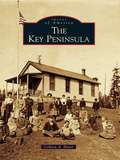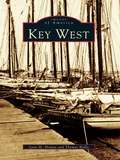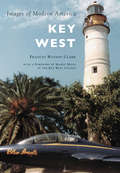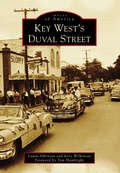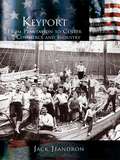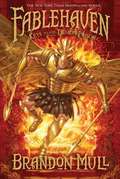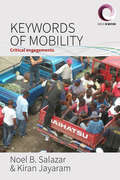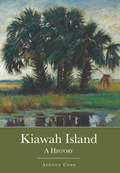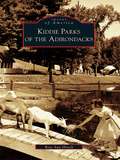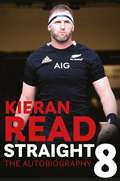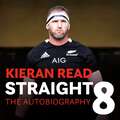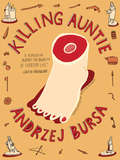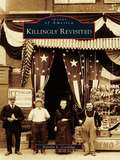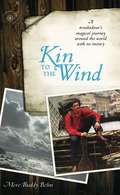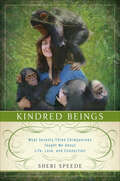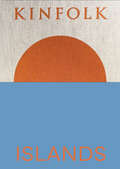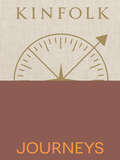- Table View
- List View
Key Concepts in Tourist Studies (SAGE Key Concepts series)
by Melanie Smith Nicola Macleod Margaret Hart RobertsonTourism is the fourth biggest industry in the world. What are the key concepts in Tourist Studies? This essential resource for students of tourism contains concise and authoritative entries on: • Planning Tourism • Sustainable Tourism • Festivals and Events • Cultural Tourism • Economics of Tourism • Regeneration • The Experience Economy • Urban Tourism • Sex Tourism Shrewdly judged to suit the needs of the modern student, the book offers the basic materials, tools and guidance for making sense of tourism and gaining the best results in essays and exams.
Key Peninsula, The
by Collen SlaterThe Key Peninsula is a scenic finger of land that stretches south between Case and Carr Inlets in Washington State. Few people lived there before 1850, although Native Americans fished and hunted from temporary villages. Several communities, each with a unique history, took root near the various bays and inlets of the peninsula, and by the 1890s, many areas bustled with schools, post offices, mills, churches, and stores. Logging, orchards, and chicken farms supported these early pioneers. Cut off from the mainland, the waters of Puget Sound provided transportation. The famous Mosquito Fleet carried products such as fruit, seafood, chickens, eggs, and butter to Olympia, Tacoma, and Seattle until the advent of the ferries and, later, the bridges. Many of today's "oldtimers" are just two or three generations distant from the original hardy settlers, but the area's residents are proud of the heritage of this unique place they call home.
Key West (Images of America)
by Lynn M. Homan Thomas ReillyMuch more than the typical vacation destination, Key West combines a free-spirited ambiance with magnificent coral reefs, a unique historic legacy with an enduring artistic sensibility. For centuries, explorers and adventurers, immigrants and entrepreneurs, artists and wanderers have come to the island oasis, and today Key West, a city like no other, is home to them all. Through hurricanes, fires, labor strikes, and the tourism boom, the community of Key West has sustained a unique way of life and attracted a wide variety of people to its shores, including such famous figures as writers Ernest Hemingway and Tennessee Williams, President Harry Truman, and musician Jimmy Buffett. Whether strolling through the downtown historic district, searching eclectic shops for one-of-a-kind treasures, enjoying a piece of key lime pie, or participating in the look-alike contest during Hemingway Days, Key West offers endless opportunities for pleasure. The landmarks, the people, and the continuing story of Key West are the entertaining subject of this new photographic tribute.
Key West (Images of Modern America)
by Frances Watson Clark Mandy MilesKey West has a colorful history. It was the beachhead that protected the United States from the Soviet Union and Cuba in the 1960s, its literary and music scenes attracted and developed writers, artists, and musicians in the 1970s, and it seceded from the Union and created a new nation, the Conch Republic, in the 1980s. Through the rest of the decades to the present, festivals, celebrations, and revelries have drawn tourists here year-round and supported the Conchs, the key's residents. The vibrant community, people and places, military presence, and significant historic sites make Key West one of the most interesting places in the United States.
Key West's Duval Street
by Jerry Wilkinson Laura Albritton Tom HambrightDuval Street, the pulsing heart of historic Key West, is one of the most legendary avenues in the United States. Stretching from the Atlantic Ocean to the Gulf of Mexico, this iconic thoroughfare has seen everyone from Ulysses S. Grant to Ernest Hemingway. Collecting remarkable archival photographs, Images of America: Key West�s Duval Street features famous buildings such as Key West�s Oldest House, St. Paul�s Church, the Southernmost House, the Strand Theater, the San Carlos Institute, and La Concha Hotel, along with fabled bars like Sloppy Joe�s and the Bull & Whistle. This book celebrates the irrepressible spirit and heritage of a much-beloved American destination.
Keyport: From Plantation to Center of Commerce and Industry
by Jack JeandronEmerging from the shores of the Raritan Bay, Keyport's roots trace back to the Kearney family's plantation and its vital role during Revolutionary times. Although just 1.4 square miles in size, it encompasses shipbuilding, oyster farming, a trolley network, and an Aeromarine industry within a rich and influential history. Beyond these are the abundant and captivating tales of catastrophic fires and the vaunted Prohibition days providing a colorful framework of life in this coastline community.
Keys to the Demon Prison (Fablehaven Series, Book #5)
by Brandon MullFor centuries, mystical creatures of all description were gathered in a hidden refuge called Fablehaven to prevent their extinction. The sanctuary survives today as one of the last strongholds of true magic in a cynical world.
Keywords of Mobility: Critical Engagements
by Kiran Jayaram Noel B. SalazarScholars from various disciplines have used key concepts to grasp mobilities, but as of yet, a working vocabulary of these has not been fully developed. Given this context and inspired in part by Raymond Williams' Keywords (1976), this edited volume presents contributions that critically analyze mobility-related keywords: capital, cosmopolitanism, freedom, gender, immobility, infrastructure, motility, and regime. Each chapter provides an historical context, a critical analysis of how the keyword has been used in relation to mobility, and a conclusion that proposes future usage or research.
Kiawah Island: A History (Brief History)
by Ashton CobbKiawah Island, located on the picturesque South Carolina coast in the heart of the Lowcountry, has a well-deserved reputation as a world-renowned destination. With its pristine beaches, award-winning golf courses and spectacular resort, Kiawah beckons to thousands of visitors from across the globe each year. Kiawah's charm, however, goes far beyond its breathtaking natural beauty and vaunted destination status. Unknown to many, the history of this beloved sea island is as captivating as its celebrated shoreline; its past as compelling as #17 on the Ocean Course. This landmark new book reveals the history of Kiawah Island as never before. Since the early eighteenth century, Kiawah has been used for myriad purposes by a wide variety of inhabitants. Kiawah Island: A History, by historian Ashton Cobb, provides a comprehensive consideration of the diverse factors and factions that have combined to shape Kiawah's fascinating history. Cobb calls upon a wide array of sources to tell the story of a South Carolina sea island that has been the site of great change through the centuries, but has remained a treasured location for generations of inhabitants and devoted visitors.
Kibo ("Brimming with Hope")
by Elizabeth AndohThis cookbook is a heartfelt and fascinating tribute to the food, traditions, and courage of the people of Japan's Tohoku region before and after the devastation of the earthquake and tsunami of March 11, 2011. It features traditional recipes such as Miso-Seared Scallops, Pinched-Noodle Soup with Pork, Salmon-Stuffed Kelp Rolls, and basics like rice, stocks, and sauces, along with sake pairings and essays on Japan in recovery from journalists and food writers. Kibō was written by Japanese culinary authority Elizabeth Andoh, who was in her Tokyo kitchen when the Great Eastern-Japan Earthquake struck. Over the following months she witnessed the strength of the people of the Tohoku region--one of the largest miso- and sake-producing areas in Japan--as they struggled with the effects of the resulting tsunami and nuclear accident. She was inspired to write Kibō (meaning "brimming with hope") to not only tell the story of the food of the Tohoku region but also to document the experiences of its people, both before and after the disaster. This lushly photographed original eBook will honor the region and its rich culture on the first anniversary of the earthquake, with a portion of the proceeds going to Japanese recovery efforts.
Kiddie Parks of the Adirondacks
by Rose Ann HirschThe first kiddie parks in North America were born in the lush forests of the Adirondack Mountains in the 1950s. These parks brought to life the characters of beloved fairytales,legends, and nursery rhymes through live performers, animated figures, and themed mechanical rides. Kiddie Parks of the Adirondacks contains images of some of the Adirondacks' most popular kiddie parks: Storytown U.S.A., Enchanted Forest of the Adirondacks, the Land of Make Believe, Magic Forest, and Santa's Workshop. Each park is home to various fantasy-themed amusements built to accommodate children rather than adults. Four of the five parks are still in operation and continue to entertain new generations of children every year.
Kids Like Me
by Lisa AguirreLittle Chloe is excited to take a special trip with her father to visit her grandmother in Haiti. As she tells her friends about the upcoming trip, Chloe and her friends wonder what the kids in Haiti are like and whether they like to do the same things like jumping rope while singing, playing soccer, working math problems and singing at church. Chloe is happy to learn that the kids in Haiti are very similar to Chloe and her friends, and they like to do many of the same things. When she returns from the trip, Chloe is excited to tell her friends at home about the kids in Haiti.
Kieran Read - Straight 8: The Autobiography
by Kieran ReadSHORTLISTED FOR INTERNATIONAL AUTOBIOGRAPHY OF THE YEAR AT THE 2020 TELEGRAPH SPORTS BOOK AWARDS.As Kieran Read calls time on his distinguished New Zealand career at the end of the Rugby World Cup, this is the open and honest life story of one of rugby's greatest players, a legendary All Black and a two-time World Cup winner.Kieran Read first played for the All Blacks as a 23-year-old in 2008 and since then has amassed more than a century of Test appearances in the famous jersey. Now, after a stellar provincial, club and international career - including back-to-back World Cup victories - the New Zealand captain writes openly and honestly about his time in the game.Read takes to these pages with his trademark determination, lifting the lid on the unique pressures of succeeding as captain the most celebrated All Black of all time (Richie McCaw). He outlines the decisions that molded his career and uncovers the skills of the coaches who shaped him, while offering readers an inside account of how the world's greatest team functions and thrives.Read unpacks the emotional toll of injury and the ignominy of defeat, neatly illustrating the intense experience of representing a rugby-obsessed nation while delivering a masterclass in how to manage the many demands on the mind and on the body.Forthright and frank, Read's well-respected views on the game and its future are a must-read for rugby fans, and his take on the myriad personalities and the peccadilloes of his team-mates, coaches and opponents will be sure to surprise and delight. From the playing fields of Papakura to the summit of the sport, Read has faced every challenge head on. His life story if no exception.
Kieran Read - Straight 8: The Autobiography
by Kieran ReadSHORTLISTED FOR INTERNATIONAL AUTOBIOGRAPHY OF THE YEAR AT THE 2020 TELEGRAPH SPORTS BOOK AWARDS.As Kieran Read calls time on his distinguished New Zealand career at the end of the Rugby World Cup, this is the open and honest life story of one of rugby's greatest players, a legendary All Black and a two-time World Cup winner.Kieran Read first played for the All Blacks as a 23-year-old in 2008 and since then has amassed more than a century of Test appearances in the famous jersey. Now, after a stellar provincial, club and international career - including back-to-back World Cup victories - the New Zealand captain writes openly and honestly about his time in the game.Read takes to these pages with his trademark determination, lifting the lid on the unique pressures of succeeding as captain the most celebrated All Black of all time (Richie McCaw). He outlines the decisions that molded his career and uncovers the skills of the coaches who shaped him, while offering readers an inside account of how the world's greatest team functions and thrives.Read unpacks the emotional toll of injury and the ignominy of defeat, neatly illustrating the intense experience of representing a rugby-obsessed nation while delivering a masterclass in how to manage the many demands on the mind and on the body.Forthright and frank, Read's well-respected views on the game and its future are a must-read for rugby fans, and his take on the myriad personalities and the peccadilloes of his team-mates, coaches and opponents will be sure to surprise and delight. From the playing fields of Papakura to the summit of the sport, Read has faced every challenge head on. His life story if no exception.
Kieran Read - Straight 8: The Autobiography
by Kieran ReadSHORTLISTED FOR INTERNATIONAL AUTOBIOGRAPHY OF THE YEAR AT THE 2020 TELEGRAPH SPORTS BOOK AWARDS.As Kieran Read prepares to call time on his distinguished New Zealand career at the end of the Rugby World Cup, this is the open and honest life story of one of rugby's greatest players, a legendary All Black and a two-time World Cup winner.Kieran Read first played for the All Blacks as a 23-year-old in 2008 and since then has amassed more than a century of Test appearances in the famous jersey. Now, after a stellar provincial, club and international career - including back-to-back World Cup victories - the New Zealand captain writes openly and honestly about his time in the game.Read takes to these pages with his trademark determination, lifting the lid on the unique pressures of succeeding as captain the most celebrated All Black of all time (Richie McCaw). He outlines the decisions that molded his career and uncovers the skills of the coaches who shaped him, while offering readers an inside account of how the world's greatest team functions and thrives.Read unpacks the emotional toll of injury and the ignominy of defeat, neatly illustrating the intense experience of representing a rugby-obsessed nation while delivering a masterclass in how to manage the many demands on the mind and on the body.Forthright and frank, Read's well-respected views on the game and its future are a must-read for rugby fans, and his take on the myriad personalities and the peccadilloes of his team-mates, coaches and opponents will be sure to surprise and delight. From the playing fields of Papakura to the summit of the sport, Read has faced every challenge head on. His life story if no exception.
Killer on the Road: Violence and the American Interstate (Discovering America #2)
by Ginger StrandStarting in the 1950s, Americans eagerly built the planet's largest public work: the 42,795-mile National System of Interstate and Defense Highways. Before the concrete was dry on the new roads, however, a specter began haunting them-the highway killer. He went by many names: the "Hitcher," the "Freeway Killer," the "Killer on the Road," the "I-5 Strangler," and the "Beltway Sniper. " Some of these criminals were imagined, but many were real. The nation's murder rate shot up as its expressways were built. America became more violent and more mobile at the same time. Killer on the Road tells the entwined stories of America's highways and its highway killers. There's the hot-rodding juvenile delinquent who led the National Guard on a multistate manhunt; the wannabe highway patrolman who murdered hitchhiking coeds; the record promoter who preyed on "ghetto kids" in a city reshaped by freeways; the nondescript married man who stalked the interstates seeking women with car trouble; and the trucker who delivered death with his cargo. Thudding away behind these grisly crime sprees is the story of the interstates-how they were sold, how they were built, how they reshaped the nation, and how we came to equate them with violence. Through the stories of highway killers, we see how the "killer on the road," like the train robber, the gangster, and the mobster, entered the cast of American outlaws, and how the freeway-conceived as a road to utopia-came to be feared as a highway to hell.
Killing Auntie
by Wiesiek Powaga Andrzej Bursa"The Polish postwar firebrand Andrzej Bursa acquired a reputation as a quick-burning, existentially tormented rebel. . . . Yet Bursa's dark humor and deadpan satire . . . keep utter bleakness at bay."-The Independent"A revolution against the banality of everyday life."-Gazeta KrakowskaA young university student named Jurek, with no particular ambitions or talents, is adrift. After his doting aunt asks him to perform a small chore, he decides to kill her for no good reason other than, perhaps, boredom. Killing Auntie follows Jurek as he seeks to dispose of the corpse-a task more difficult than one might imagine-and then falls in love with a girl he meets on a train. Can he tell her what he's done? Will that ruin everything?"I'm convinced-simply-that we are all guilty," says Jurek, and his adventures with nosy neighbors, false-toothed grandmothers, and love-making lynxes shed light on how an entire society becomes involved in the murder and disposal of dear old Auntie. This is a short comedic masterpiece combining elements of Fyodor Dostoevsky, Jean-Paul Sartre, Franz Kafka, and Joseph Heller, coming together in the end to produce an unforgettable tale of murder and-just maybe-redemption.Andrzej Bursa was born in 1934 in Krakow, Poland, and died twenty-five years later. In his brief lifetime he composed some of the most original Polish writing of the twentieth century. Killing Auntie is his only novel. His brilliant career and tragic early death established him as a cult figure among restless and disenchanted youth.
Killingly Revisited
by Natalie L. CoolidgeIn the first volume, Killingly revealed the initial manufacturing emphasis in the town's villages. Killingly Revisited illustrates how the town survived after losing most of the textile industry, as it moved South, by actively seeking diversified commercial businesses. Within these pages, the town's fascinating past is displayed as newly acquired vintage views are coupled with information recently uncovered from the Killingly Historical and Genealogical Society's newspaper archives and other reference materials. In celebration of 300 years asan incorporated Connecticut town, the society is sharing photographs of Killingly's mills, businesses, buildings, churches, schools, andcemeteries. There have been losses from devastating fires that changed the face of Main Street. New streets and roads were added as modes of transportation changed. There are also new views of citizens at work and play.
Kin to the Wind
by Moro Buddy BohnKin to the Wind is the memoir of Moro, a gifted virtuoso guitarist and composer, who first played (and wrote his first composition) when he was six and performed his first of many concerts when he was twelve. The book recounts his journeys as he traveled the world as a troubadour, using only his guitar performances as currency. This talented former member of the world-famous New Christy Minstrels played in over 50 countries-in royal palaces, African casbahs, and even on a British warship in trade for his passage across the Indian Ocean. Bedouin smugglers took him across the Arabian Desert in their camel caravan, listening to his music beneath desert stars. While he was in Bangkok giving a command performance for Their Majesties King Bhumibol and Queen Sirikit of Thailand, the U.S. military invited him to play for the troops at their jungle camps. And he became the first entertainer to perform for American forces in the Vietnam conflict. He was also the first entertainer to appear at Paul Newman's famous 1960s exclusive Hollywood discotheque, THE FACTORY, where he played nightly. He followed that with an engagement at Howard Hughes' CABARET ROOM in Las Vegas where Mr. Hughes personally came to hear him. An Italian duchess who found him performing with a street-dancing flamenco troupe of gypsies in 1961 assisted him in obtaining a visa for Algeria where he then toured-during the violent Seven Years' War-and S.A.O. terrorists captured and held him. He played for them, literally for his life, whereupon they gave him money and let him go. Moro's memoir is an account of life's magic, suffused with an almost childlike innocence in his pursuit of dreams and his belief in the goodness of people the world over.
Kind Hearts and Coriander: perfect for fans of THE LIST!
by April HardyPERFECT FOR FANS OF THE LIST AND THE I HEART SERIESA heartwarming romantic comedyOn her mum’s death, sous chef Polly Hanson learns she may be hotelier Charles Hetherin’s illegitimate daughter. She’s grown up watching her mother struggle and do without, and she’s furious. The Hetherins have it all, including fabulous Hetherin Hall country house hotel. Determined to discover whether or not Charles is her father, Polly’s mistaken for a job applicant and finds herself working as a waitress at the Hall. Getting to know what might be her family, she can’t help but start to fall in love with them and their quirky ways.Romance is the last thing on her mind. But she can’t deny the sparks flying between her and Oliver, the grumpy but gorgeous restaurant manager. However, it seems no one is quite who Polly thinks they are…
Kind Hearts and Coriander: perfect for fans of THE LIST!
by April HardyPERFECT FOR FANS OF THE LIST AND THE I HEART SERIESA heartwarming romantic comedyOn her mum’s death, sous chef Polly Hanson learns she may be hotelier Charles Hetherin’s illegitimate daughter. She’s grown up watching her mother struggle and do without, and she’s furious. The Hetherins have it all, including fabulous Hetherin Hall country house hotel. Determined to discover whether or not Charles is her father, Polly’s mistaken for a job applicant and finds herself working as a waitress at the Hall. Getting to know what might be her family, she can’t help but start to fall in love with them and their quirky ways.Romance is the last thing on her mind. But she can’t deny the sparks flying between her and Oliver, the grumpy but gorgeous restaurant manager. However, it seems no one is quite who Polly thinks they are…
Kindred Beings: What Seventy-Three Chimpanzees Taught Me About Life, Love, and Connection
by Sheri SpeedeEnter a world of tender friendships, staunch loyalties, violent jealousies—and enduring love.As a child, Sheri Speede knew that she wanted to advocate for animals in any way she could. But it was not until many years after veterinary school, when she was transporting a chimpanzee named Pierre away from a biomedical facility as part of her job as a conservation advocate in Cameroon, that Dr. Speede discovered her true calling. She began to search for land for a forest sanctuary for captive chimpanzees that were held on chains and in small cages at local hotels.Dr. Speede eventually founded the Sanaga-Yong Chimpanzee Rescue Center, a forested home for orphans of the illegal ape meat trade. One chim- panzee, Dorothy, was rescued by Dr. Speede and her colleagues from a bleak existence imprisoned on a chain and forged a deep friendship with her. Dr. Speede explains how chimpanzees, like humans, are capable of a broad spectrum of emotional behaviors—both hateful and loving. Dr. Speede also candidly reveals her own struggles as a stranger in a foreign culture trying to adjust to rural African village life. And she admits that unlike Dorothy, she was not always kind, gentle, and forgiving.Dorothy died of old age at the sanctuary, and a photograph of Dorothy's funeral, in which Dr. Speede cradled Dorothy's head while her family of chimpanzees mournfully viewed her body, went viral after being published in National Geographic. The world was surprised at the depth of the chimps' grief at the loss of their friend, but Dr. Speede was not. Through the chimps, she had come to understand the meaning of love, loyalty, and true connection.While this is a compelling story about the emotional complexity of the chimpanzees she rescued and befriended, it is also Dr. Speede's story. Major events in her personal life, including love affairs, dangerous run-ins with criminals, and the birth of her daughter, unfold as the development of her primate rescue center runs parallel to her own development. Ultimately, Kindred Beings is a story of profound resilience, of both the apes and the woman who loved them.
Kinfolk Islands (Kinfolk Adventures)
by John Burns&“Wanderlust inspiration.&”—GQ, The Best Gifts for Coworkers Join Kinfolk on a journey off the beaten track, to islands big and small, in this collection of eighteen new travel stories. Whether it&’s a tour of the otherworldly landscape of Socotra in Yemen or a hike into the old growth of a Japanese forest on Yakushima, each slow travel itinerary invites you to set sail at a pace that allows for true discovery and immersion. Filled with ideas and inspiration for where to escape, explore and unwind, Kinfolk Islands is full of vibrant photography, practical guidance and thoughtful reflections on why the idea of an island embodies so many of our travel fantasies. There are the charms of urban islands, including Montréal&’s beloved Mile End neighborhood. Truly unexpected destinations, like Hormuz, off the coast of Iran, with its psychedelic scenery and bohemian spirit. Italy&’s sun-soaked Ponza, perfect for languid afternoons. And of course some of the world&’s most beautiful beaches, from jungle-fringed Caribbean sands to rugged and remote Nordic shores. Believing that travel is as much a state of mind as an action or itinerary, Kinfolk celebrates a way of exploring our world that not only fosters thoughtful perspectives on the places we visit but also deepens our relationship with home once the journey is over.
Kinfolk Journeys
by John BurnsAn unforgettable journey to breathtaking destinations around the world. Venture beyond the familiar with Kinfolk Journeys, a celebration of inspiring and sustainable ways to travel slower and see the world anew. Take a subterranean tour of Tashkent, join a local mailman on his delivery route through rural New Zealand or sail the high seas en route to Antarctica—these stories will transform the way you travel, no matter the locale or distance. Kinfolk Journeys is filled with ideas for day trips, weekend breaks and grander adventures that center around slower modes of transport—road, rail, sea and trail—and encourage us to be our own guides along the way. Featuring lush photography, practical advice and thoughtful reflections on responsible travel, the eighteen stories in this collection take us to some of the world&’s most extraordinary landscapes, from Namibia&’s daring and desolate coastline to the most remote reaches of Australia. Guided by the belief that travel is as much a state of mind as an action or itinerary, Kinfolk Journeys is about exploring our world in a way that not only fosters thoughtful perspectives on the places we visit but also deepens our relationship with home once the journey is over.
Kinfolk Travel: Slower Ways to See the World (Kinfolk)
by John BurnsExplore the art of mindful travel with Kinfolk, the pioneers in &“slow living,&” their philosophy of simplicity, authenticity, intentionality and community. With nearly 450,000 copies in print, the Kinfolk series has applied this philosophy to entertaining (The Kinfolk Table), interior design (The Kinfolk Home), and living with nature (The Kinfolk Garden). Now they have turned their attention to &“slow travel,&” offering readers a road map for planning trips that foster meaningful connections with local people and authentic experiences of local culture. Go museum hopping in Tasmania, or birdwatching in London. Explore the burgeoning fashion community in Dakar. Take a bicycle tour through Idaho, or a train trip from Oslo to Bergen. Drawing on the magazine&’s global community of writers and photographers, Kinfolk Travel takes readers to over 20 location across five continents, with travel tips from locals, stunning images, and thoughtful essays.

